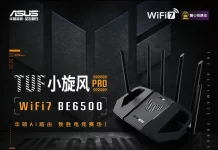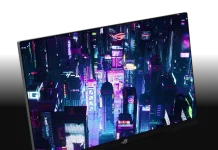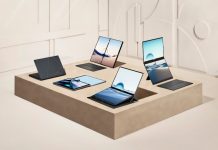The Asus Zenbook 17 Fold OLED has been available in the US and Canada since October this year. When it arrived in India in November, I got the opportunity to lay my hands on India’s first laptop with a foldable screen. I am writing this review after using it as my primary device for over a month. I had planned to post by early December but delayed it to see if the Zenbook 17 Fold OLED’s foldable screen would get any creases. I can say that I am quite impressed with Asus’ first iteration of a foldable screen laptop. In fact, I felt the void when I had to return to the review unit. Here’s my review of the Asus Zenbook 17 Fold OLED.
Asus Zenbook 17 Fold OLED – What’s in the box?
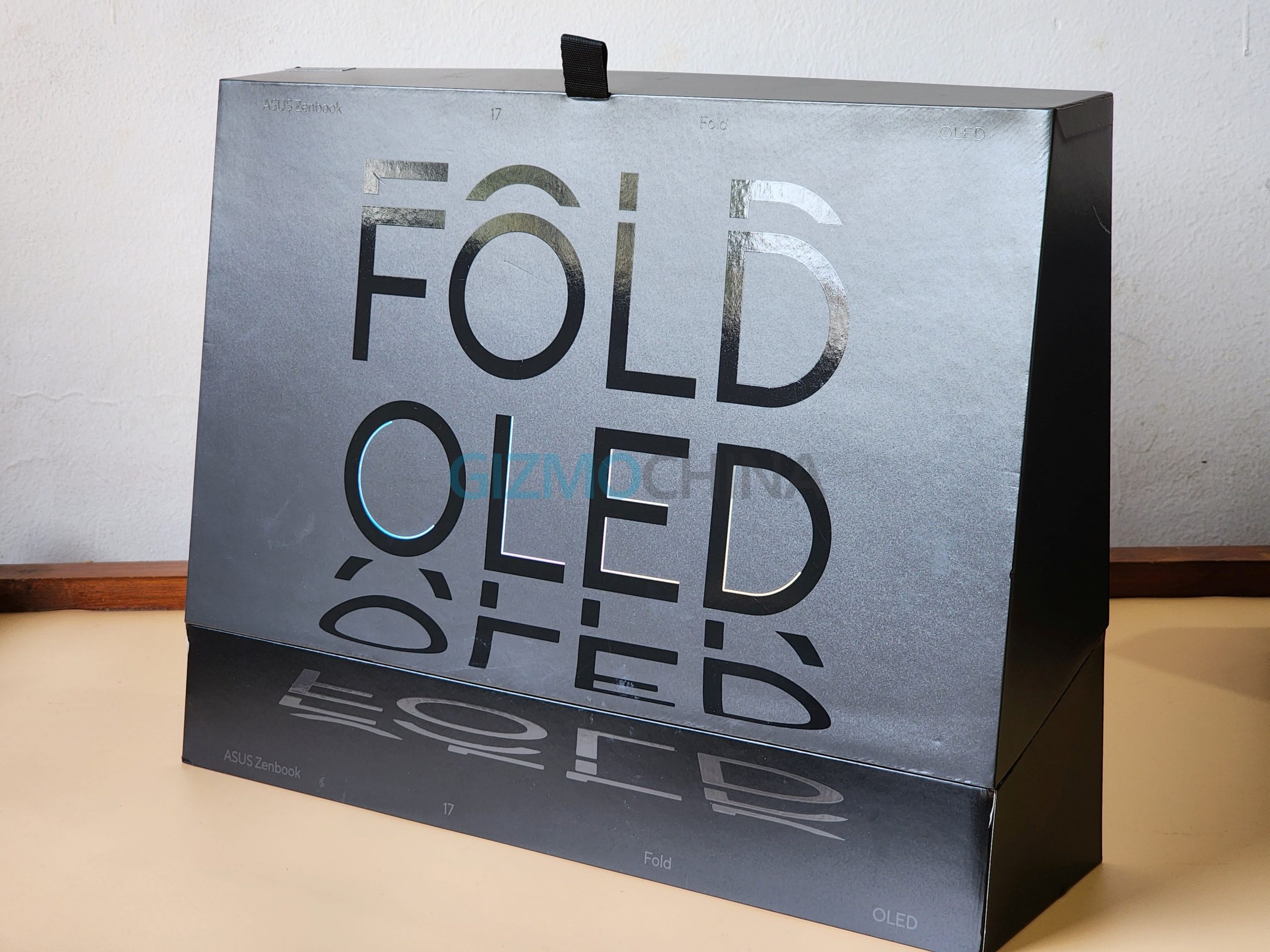
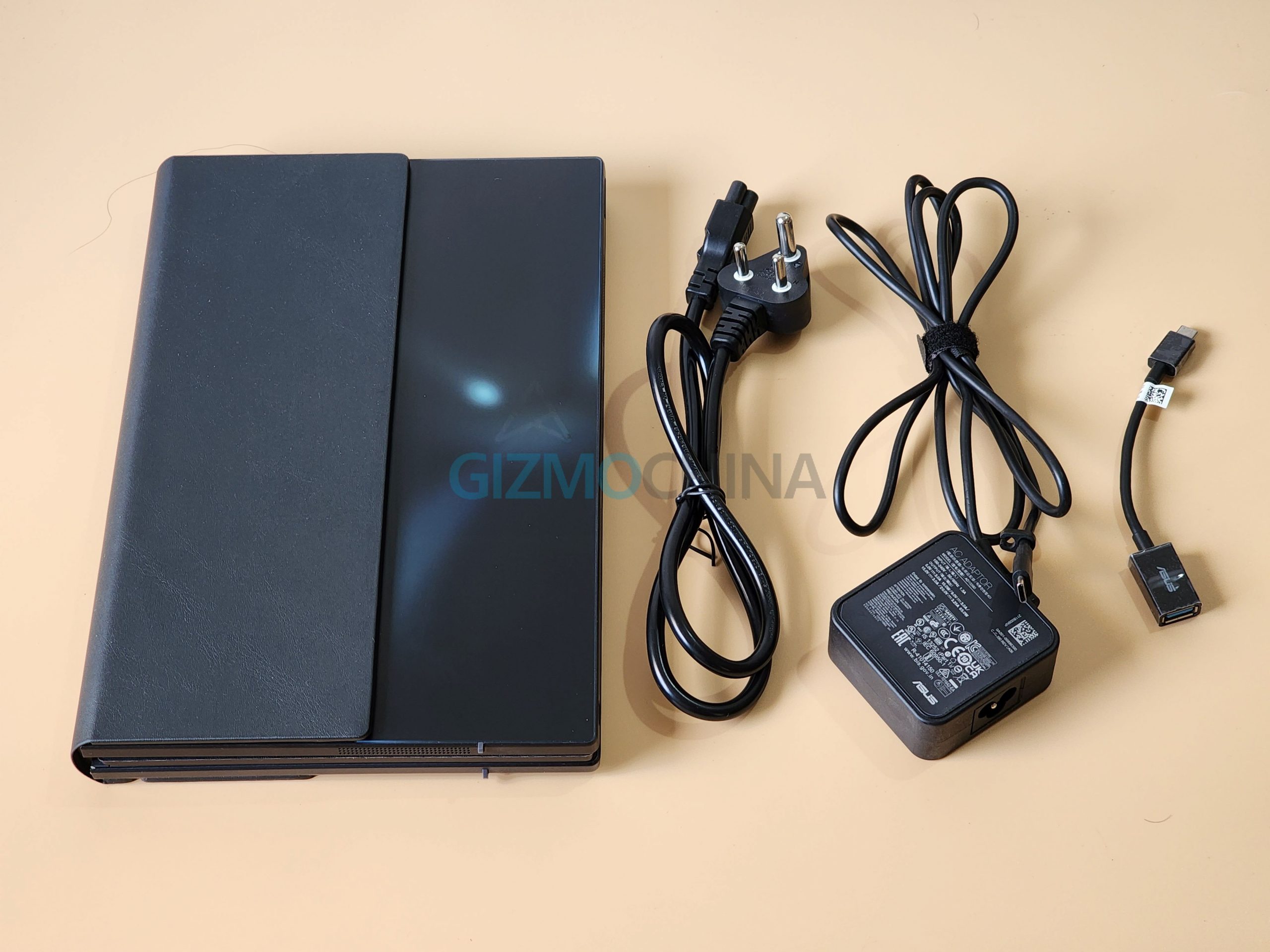
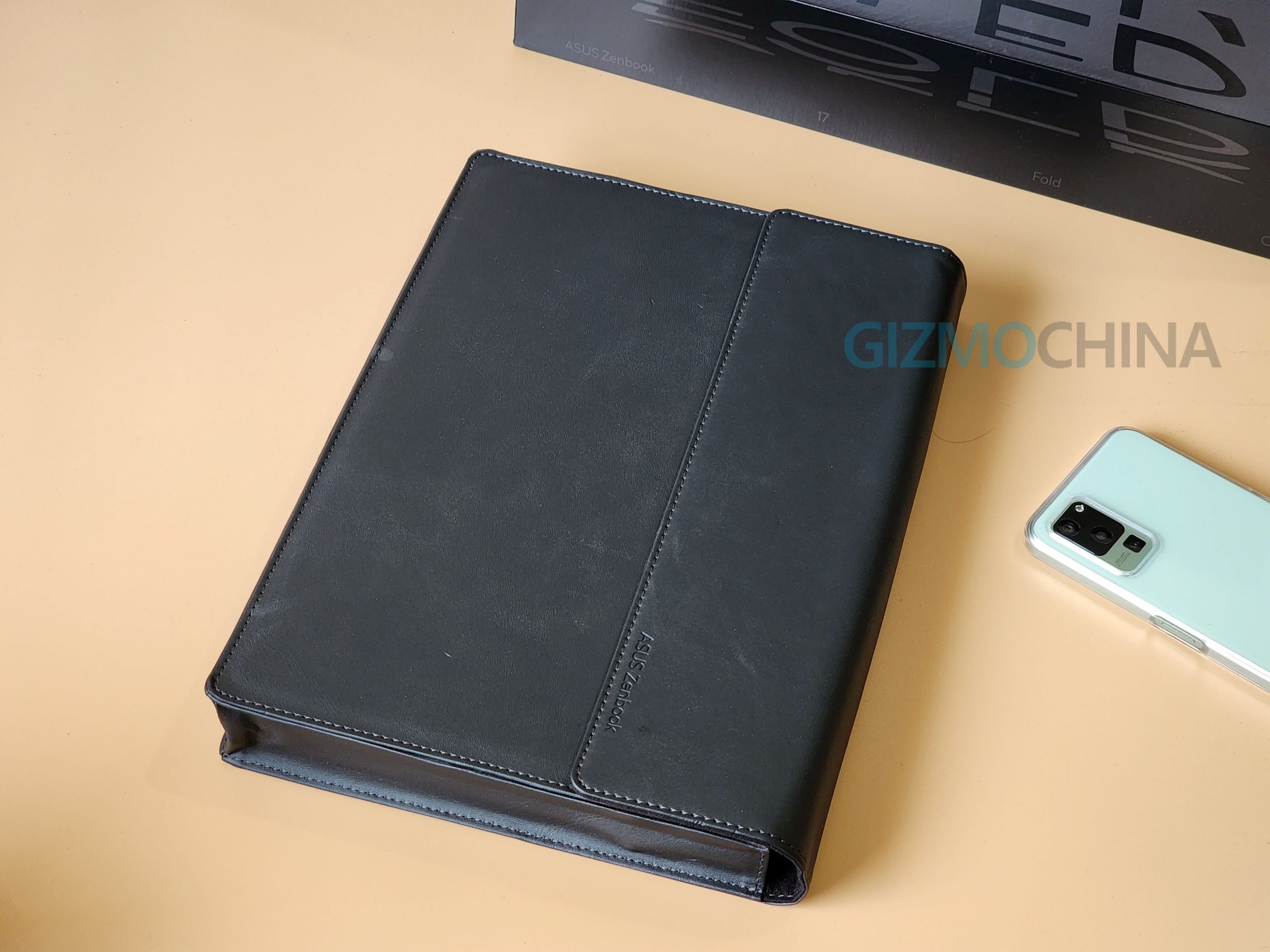
The Zenbook 17 Fold OLED comes in a big retail package. Inside it is a uniquely designed box (which can be seen below), which houses the following items:
- Zenbook 17 Fold OLED (model number UX9702)
- Ergosense Bluetooth keyboard
- 65W AC adapter
- UBS-C to USB-A dongle
- Sleeve (faux leather)
- User manual
Design and Durability
| Dimensions | Display | |
| Unfolded: 378.5 x 287.6 x 8.7 ~12.9 mm | 17.3-inch foldable OLED touchscreen | 133% sRGB door gamut |
| Folded: 287.6 x 189.3 x 17.4 ~34.4 mm | 4:3 aspect ratio | 100% DCI-P3 color gamut |
| Weight – 1.5kg (without keyboard) | 2560 x 1920 pixels resolution | 10-bit colors |
| – 1.8kg (with keyboard) | 87% screen-to-body ratio | VESA CERTIFIED Display HDR True Black 500 |
| Color: Tech Black | 60Hz refresh rate | 0.2ms response rate |
| Durability | 500 nits of peak brightness | Pantone validated |
| MIL-STD-810H certified | 1,000,000:1 contrast ratio | Dolby Vision, HDR support |
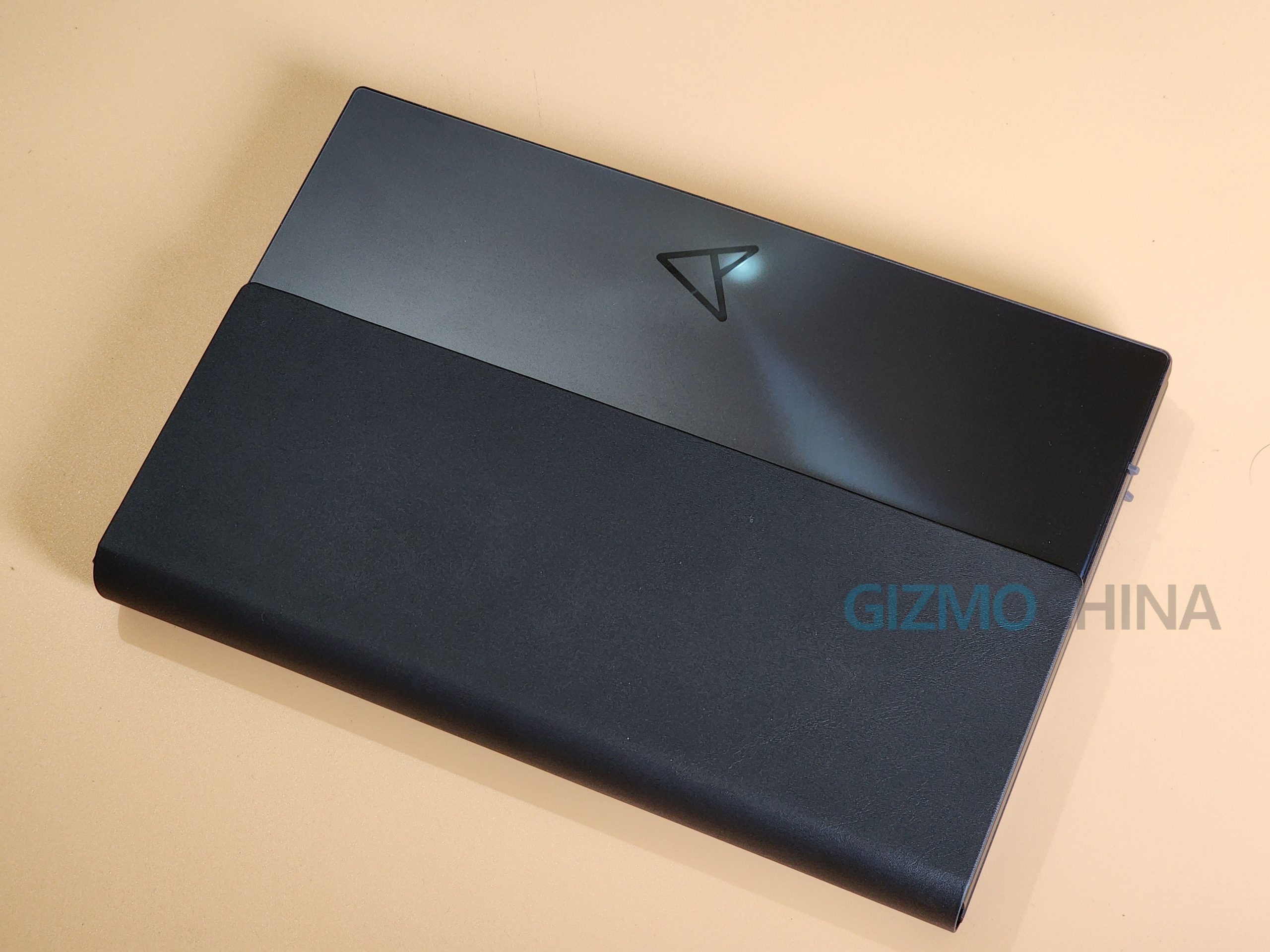
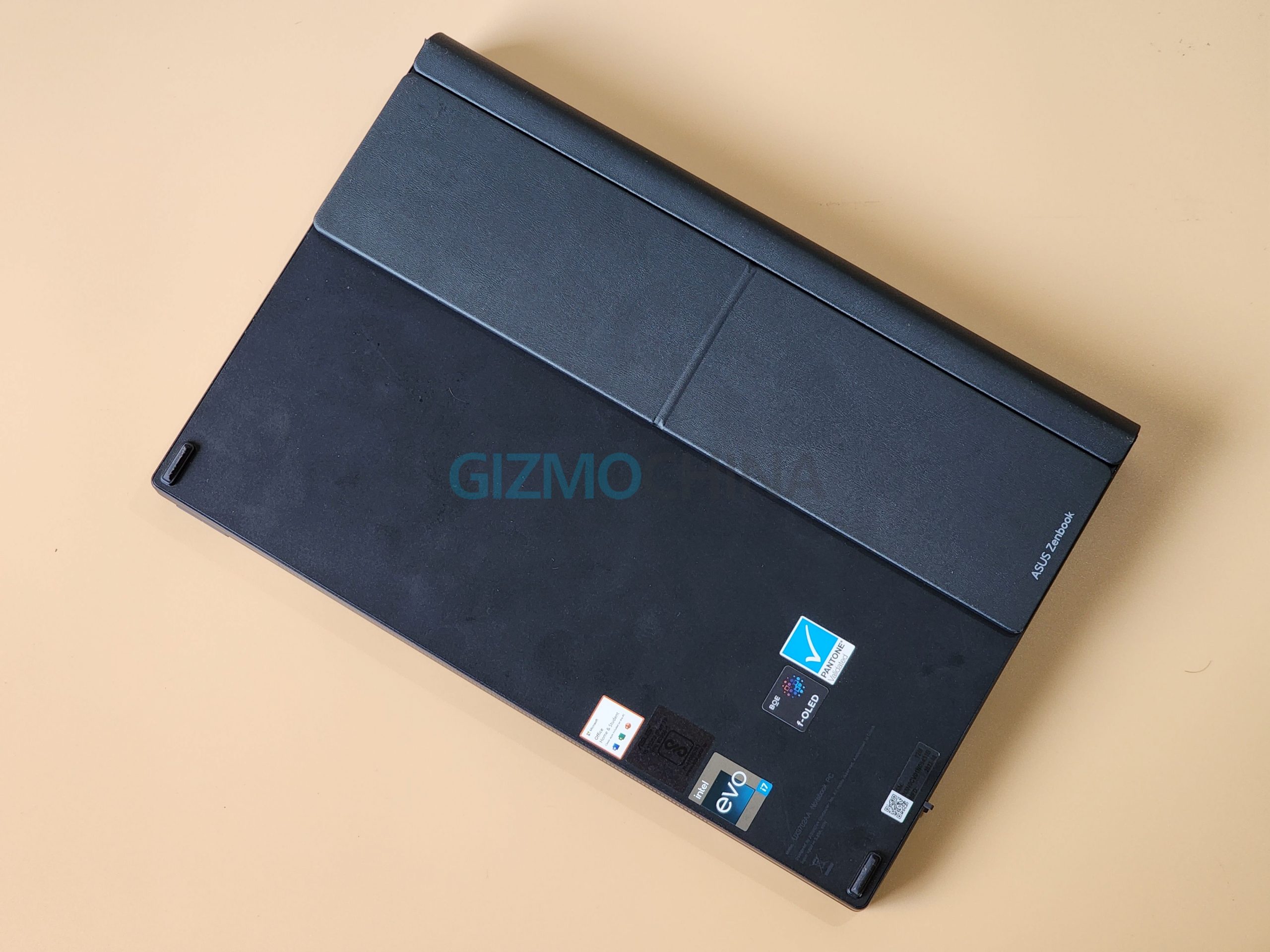
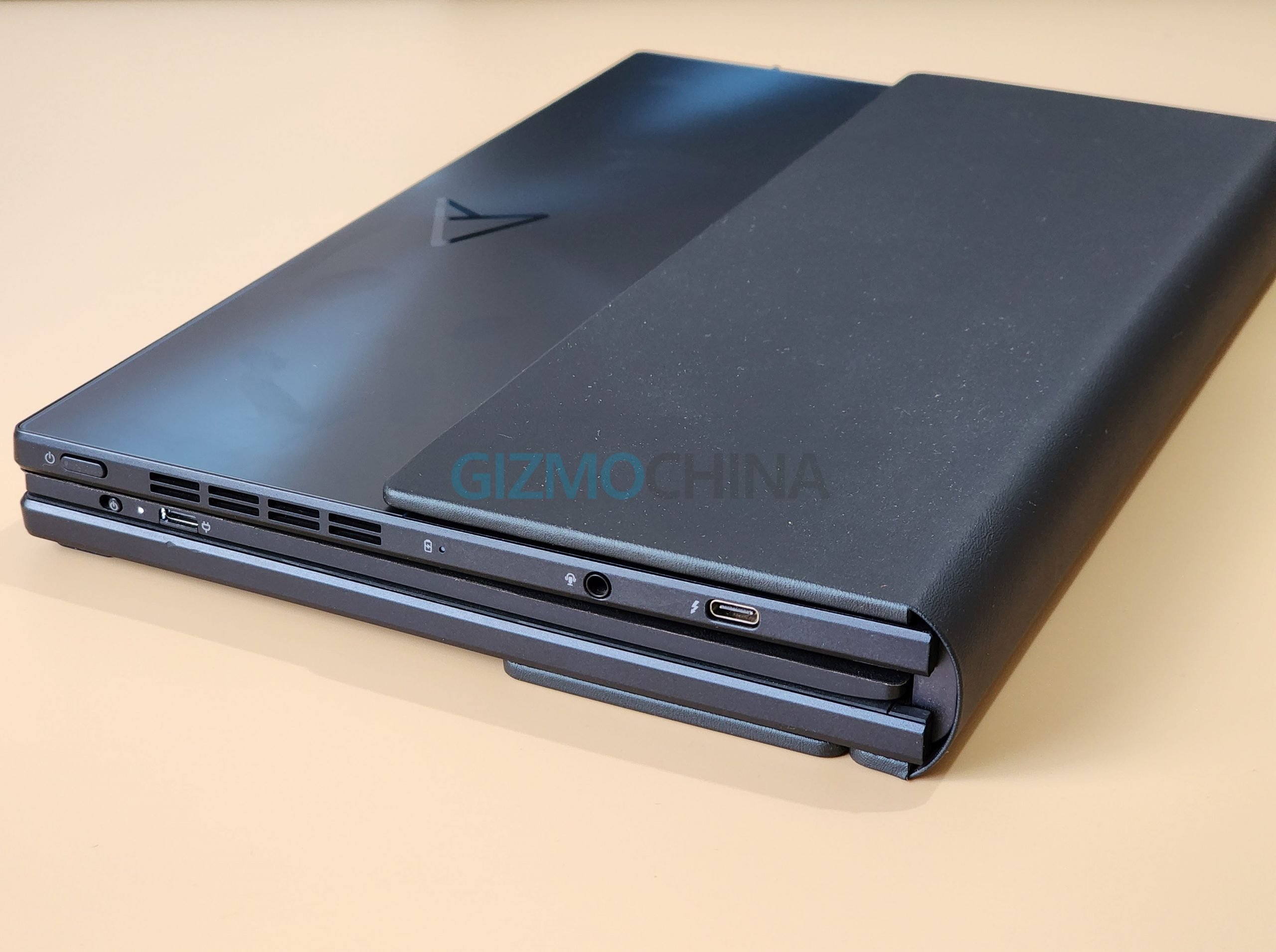
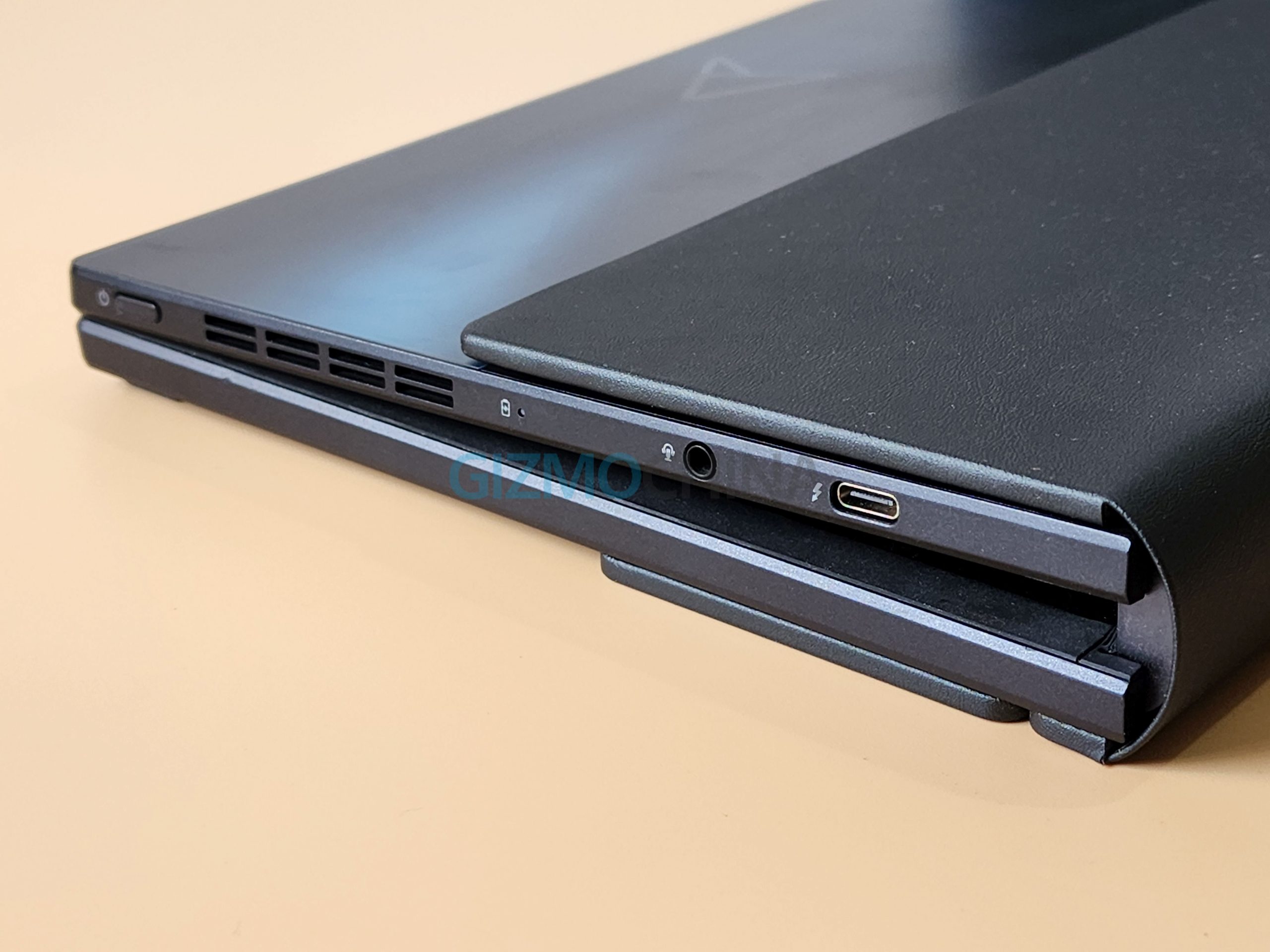
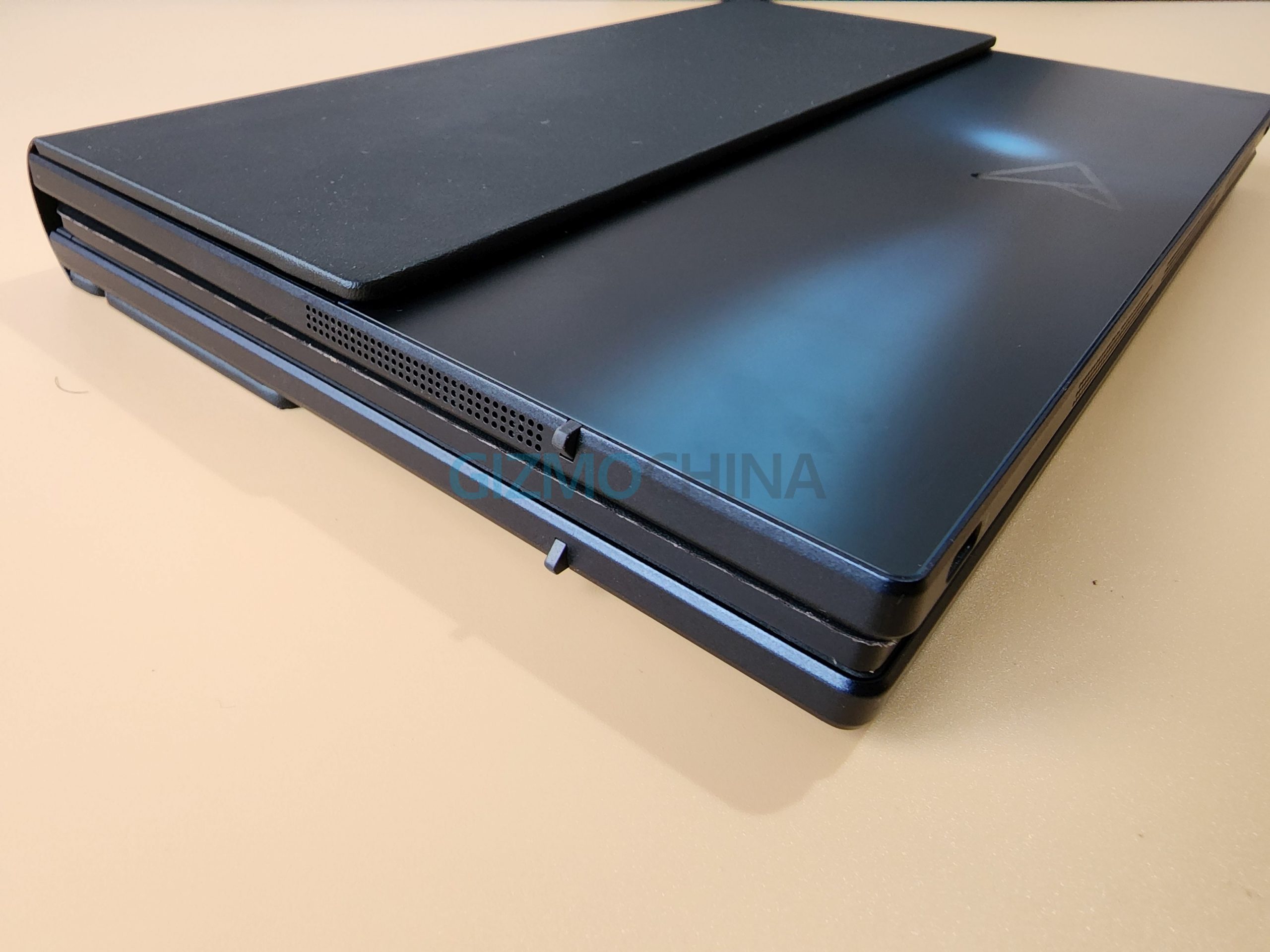
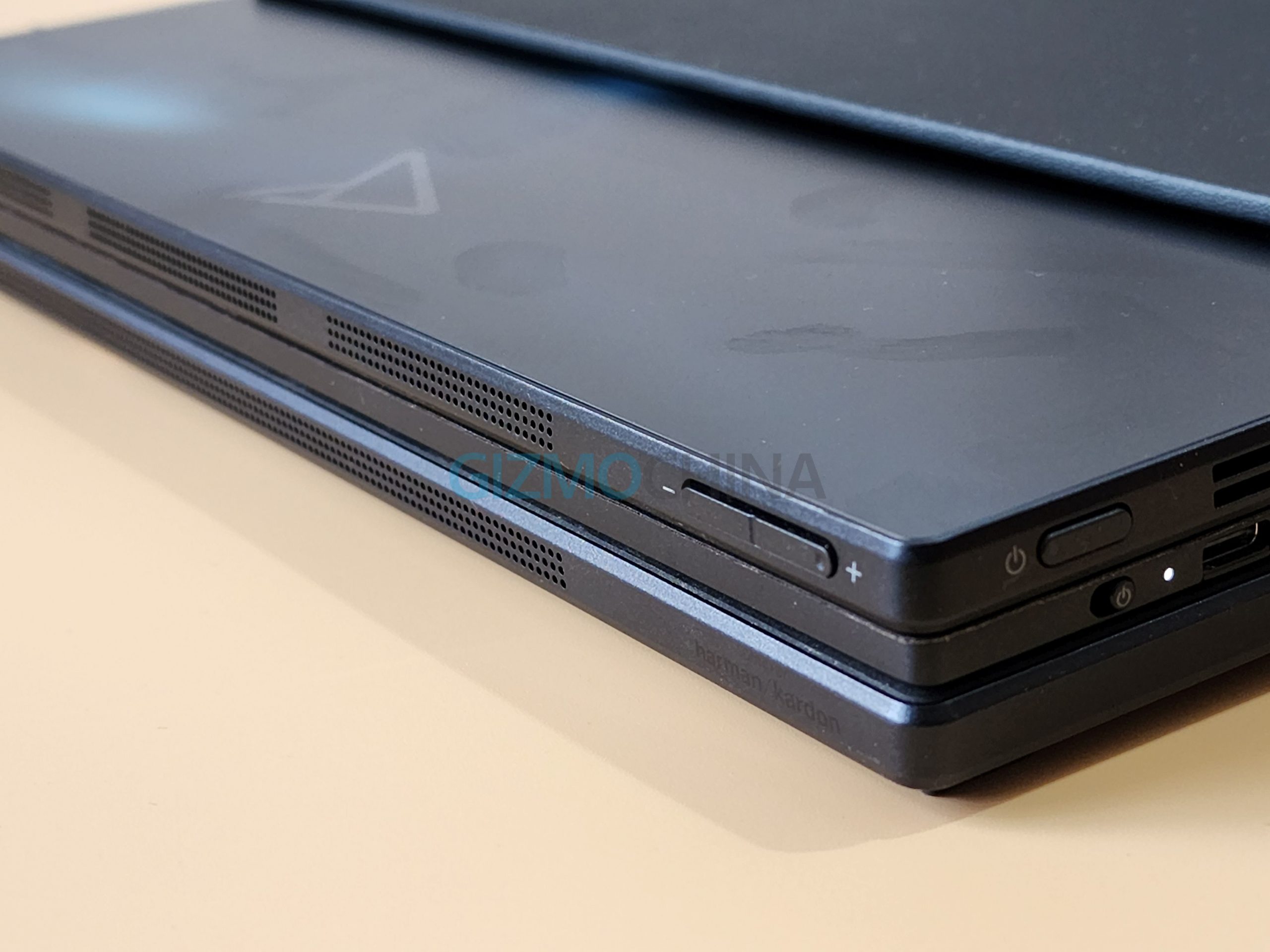
The Zenbook 17 Fold OLED has a sturdy build, with a combination of magnesium alloy for the Asus arrow logo and dark green (almost black) faux leather on the remaining back. The latter protects the hinge and houses a kickstand. There is no need for a rear camera on such a device. Hence, it does not have one. In the folded state, the Bluetooth keyboard can be placed between the two halves of the device.
When unfolded, the topside of the device features a power key with an LED, air vents, a battery charger indicator, a 3.5mm headphone / audio jack, and a Thunderbolt 4 port (for data transfer / charging). On the bottom, it has other air vents. The speakers are available on the right and the left. The right side also features the Dolby Vision Atoms and Harman / Kardon logos, whereas the left side also has another Thunderbolt 4 port and a volume button.
Internally, the upper half of the Zenbook 17 Fold OLED packs the motherboard, processor, RAM, SSD storage, cooling fan, and other components. Asus’ proprietary hinge is in the middle, and the other half packs the battery.
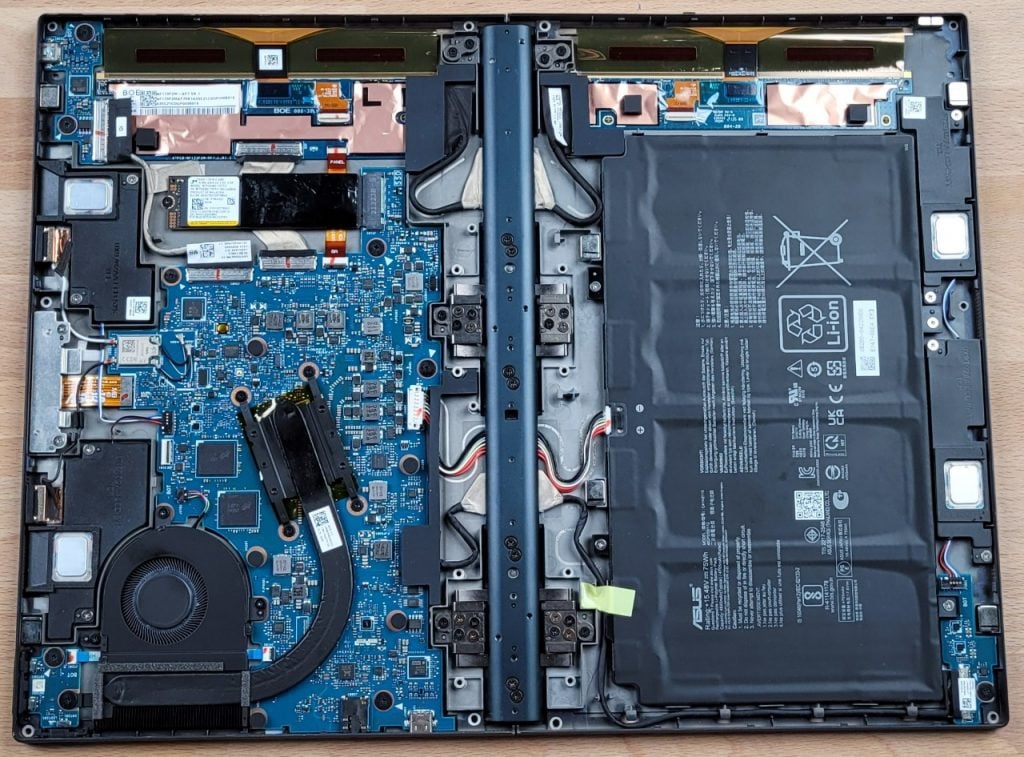
The Ergosense Bluetooth keyboard comes equipped with a trackpad. It has a power switch, a charging indicator, and a USB-C port for charging. More on the keyboard a bit later in the review. Including the keyboard, the device weighs around 1.8kg, which makes it quite bulky. When unfolded, the device has a thickness of 8.7mm. The keyboard is also quite slim, measuring only 5.5mm in thickness.
What about the durability of the Zenbook 17 Fold OLED? Asus claims that the hinge of the device has been tested for 30,000 opening and closing cycles. In addition, it meets the MIL-STD-810H standard for reliability and durability, which means it is built to withstand the toughest environments, including extreme altitudes, temperatures, and humidity.
Foldable Display and Crease
The Zenbook 17 Fold OLED can be used in multiple modes, such as desktop mode, laptop mode (with Bluetooth keyboard), laptop mode (with on-screen keyboard), extended mode, reader mode, and tablet mode.

Asus Zenbook 17 Fold
When fully unfolded and used in desktop mode, the device offers a 17.3-inch screen with a 2560 x 1920 pixels resolution, and a 4:3 aspect ratio. The bezels were not too thick in my opinion, but they are not as thin as those found on some flagship laptops. The left bezel (in desktop mode) houses the webcam with IR sensors. When folded and used in laptop mode, it offers a 12.5-inch screen space, 1920 x 1080 pixels resolution, and a 3:2 aspect ratio.
I mostly used the Zenbook 17 Fold OLED in desktop mode for working, and I even watched a couple of F1 races on it. While travelling or in a café, I switch to laptop mode. I truly liked working on this device. The bright OLED panel produces realistic colors. In addition, it supports Dolby Vision and HDR.
The display crease is visible when the device is off, and when it is turned on, the crease is slightly visible when viewed from the right or left. It can also be felt when the screen is touched at the center. However, it does not affect its use at all. In fact, it was never visible when I worked on it. Since I got the chance to use it for more than four weeks, neither the display crease nor the underlying hinge developed any issues.
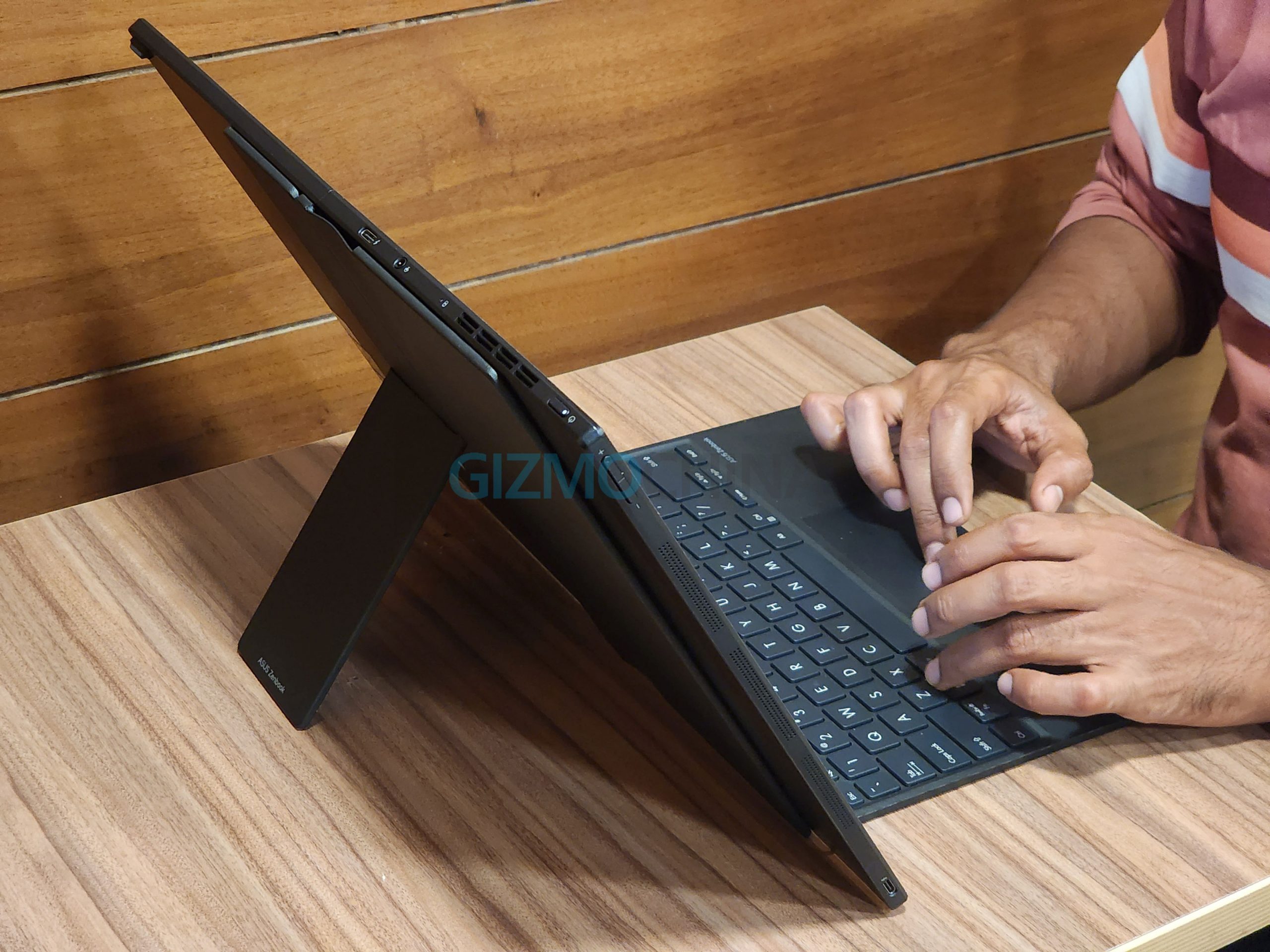
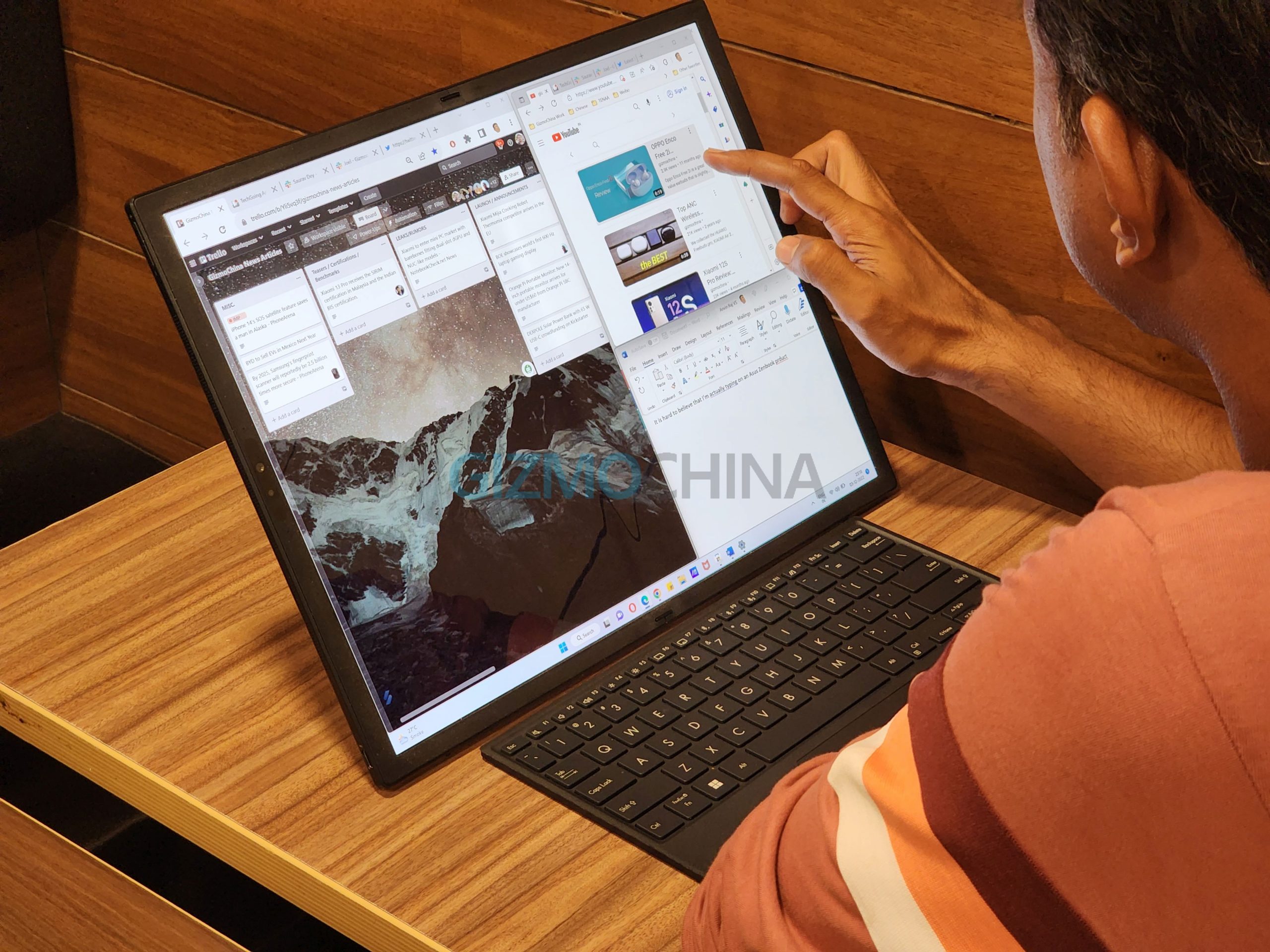
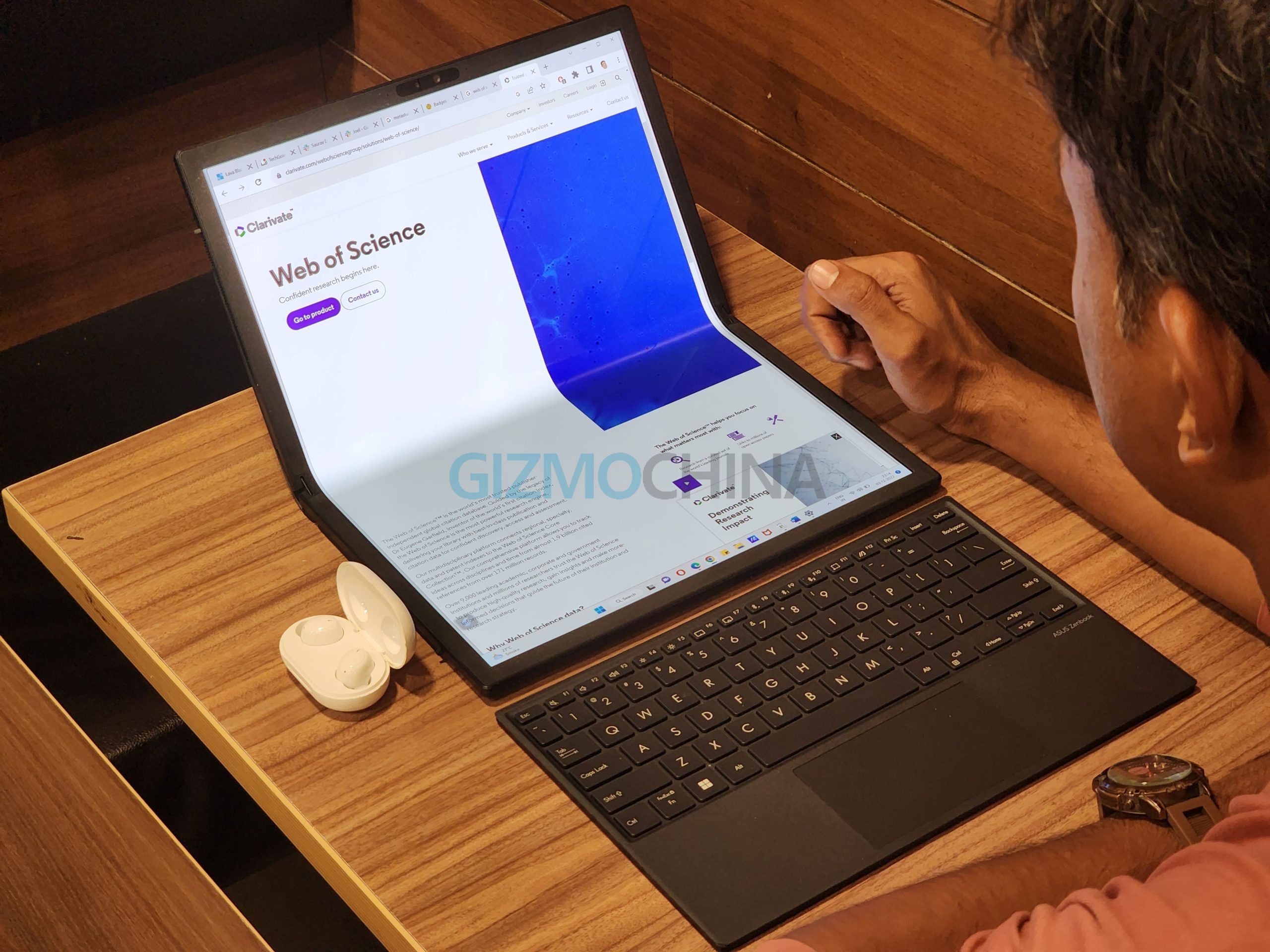
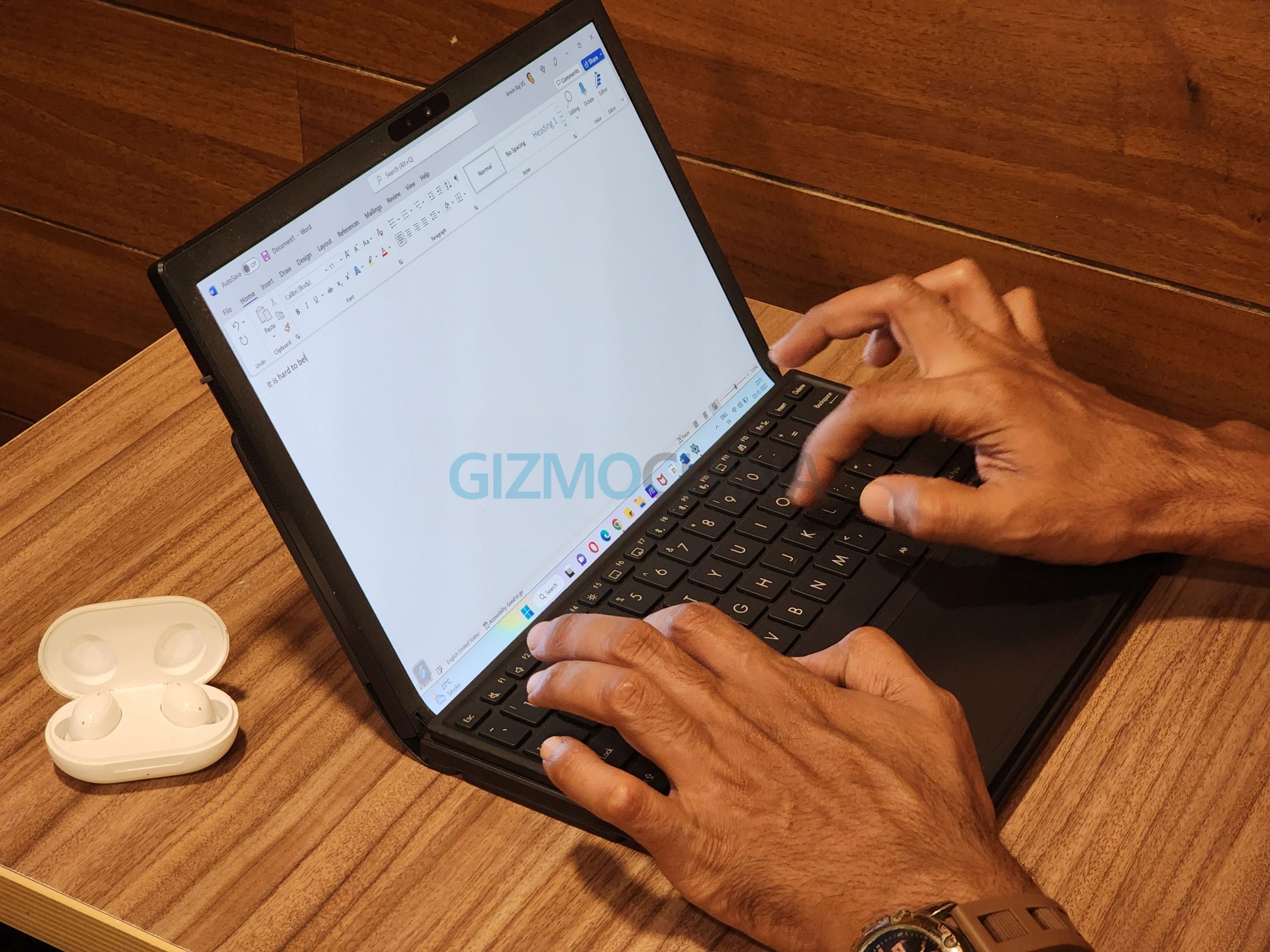
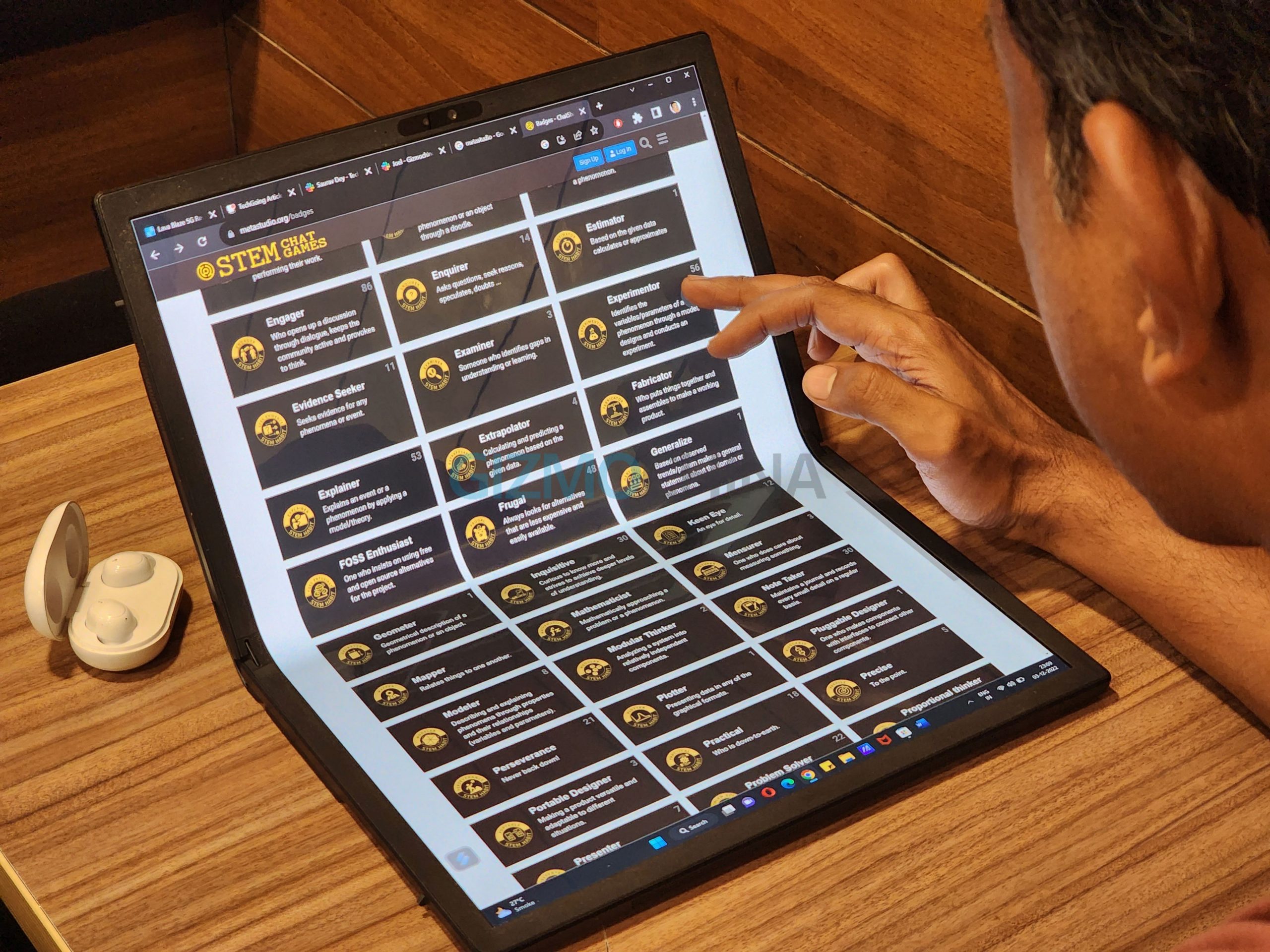
So, what issues did I face with the foldable screen? I mostly used the screen with a brightness setting of around 34 percent. However, when I connected a charger, the display would go off and come back in a second. I am not really sure whether this issue is specific to the review unit I received. Every time it happened, the display would come back brighter as if it were set at 80 percent brightness, even though it was actually set at 35 percent. The brightness would then gradually decrease on its own. It’s not a major problem, and it could be resolved with a software update. The other thing that I felt was that the screen should have offered a higher refresh rate.
Even when the display brightness is high, the foldable OLED panel does not cause eye fatigue. According to Asus, the screen produces 70 percent less harmful blue light than an LCD display.
It would have been good if the Zenbook 17 Fold OLED had supported a stylus. The footnote on the official page of the device reads, “When using the device, please avoid using a stylus or sharp items to touch the display, as they might damage the display.” The reason for this is that foldable screens are not made of glass, but of plastic, which is sensitive to scratches and damage. Also, there is no protective layer like the UTG (ultra-thin glass), which is available on Samsung’s Galaxy Z Fold-series foldable smartphones.
Keyboard
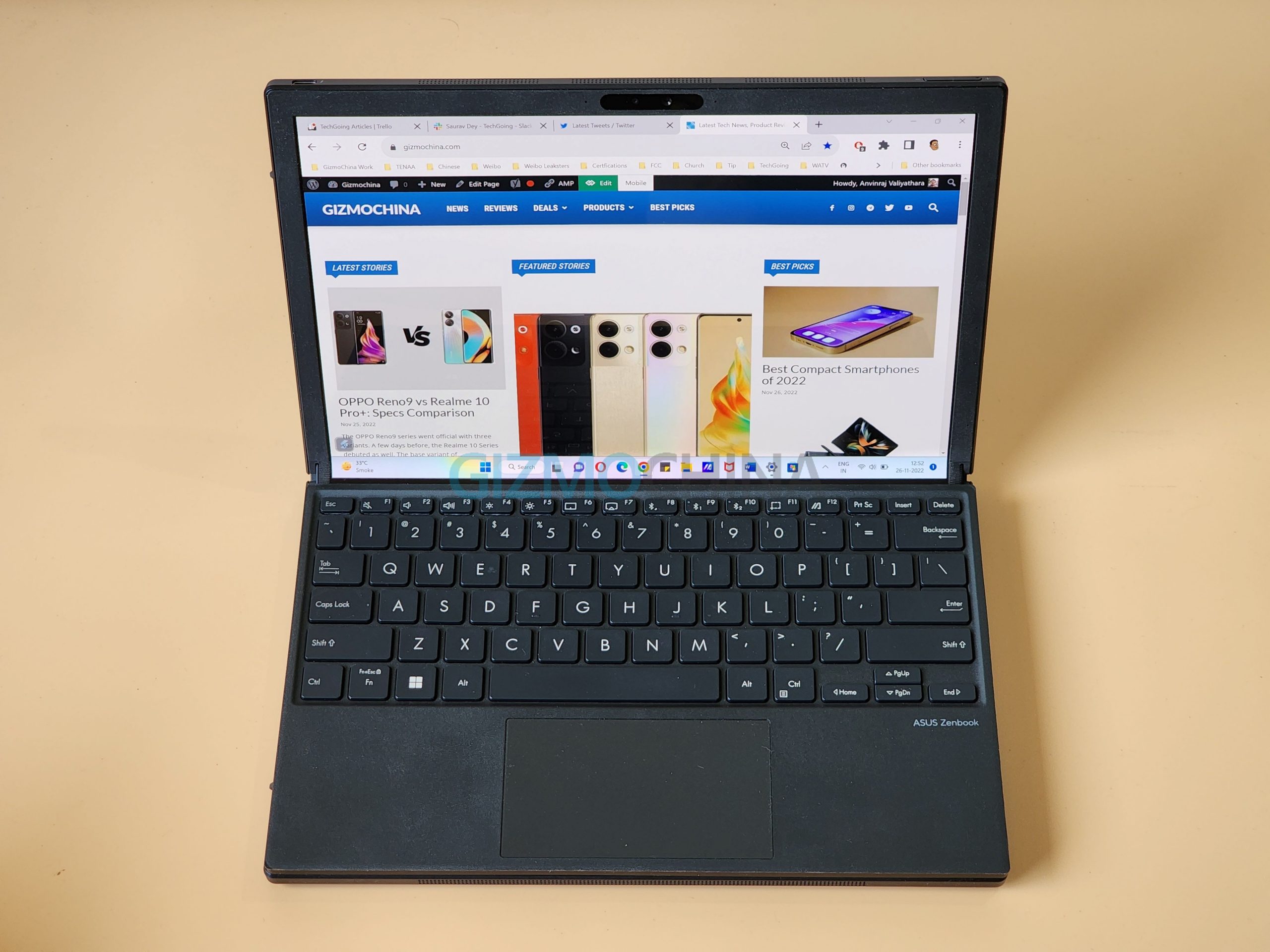
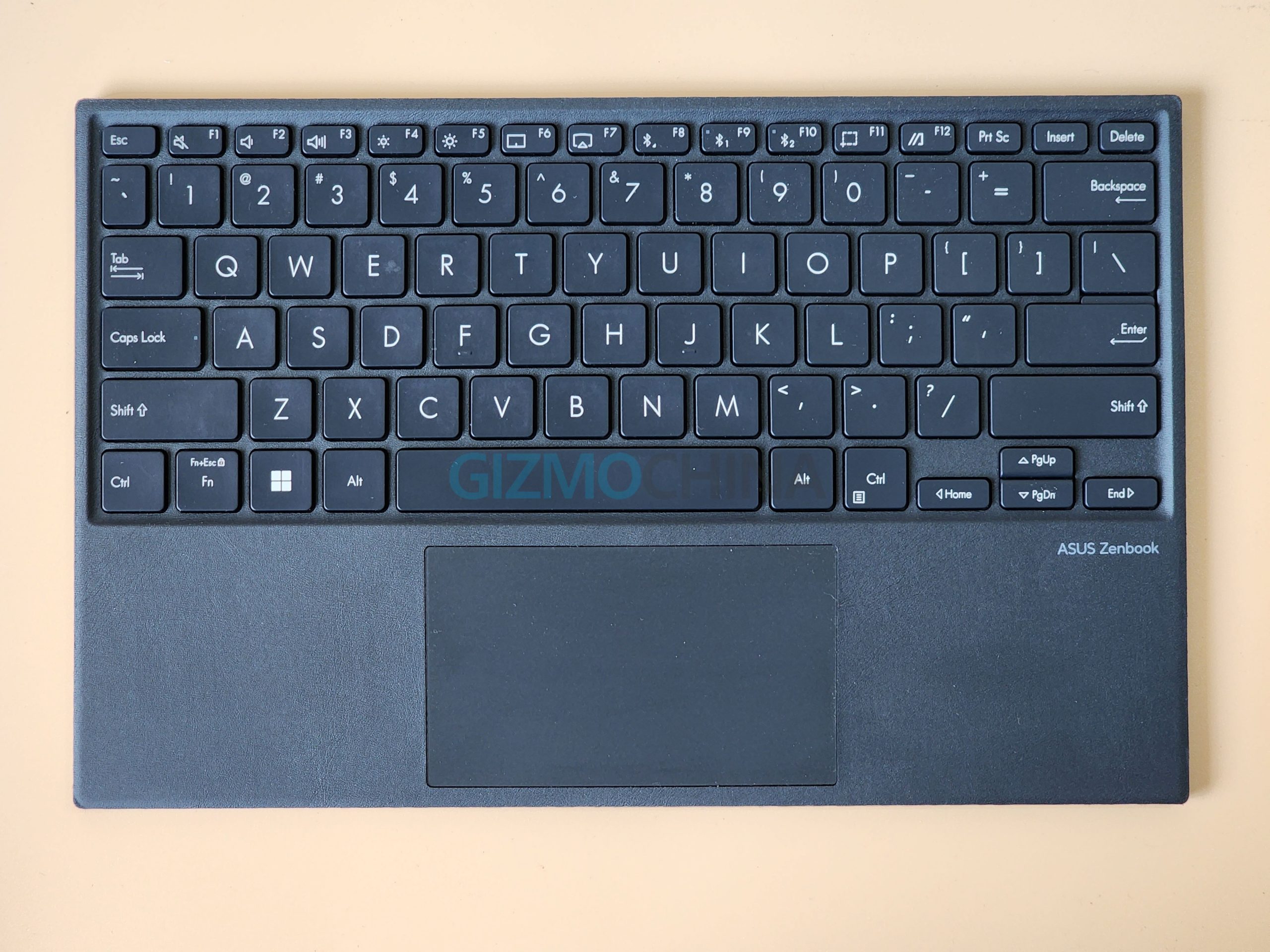
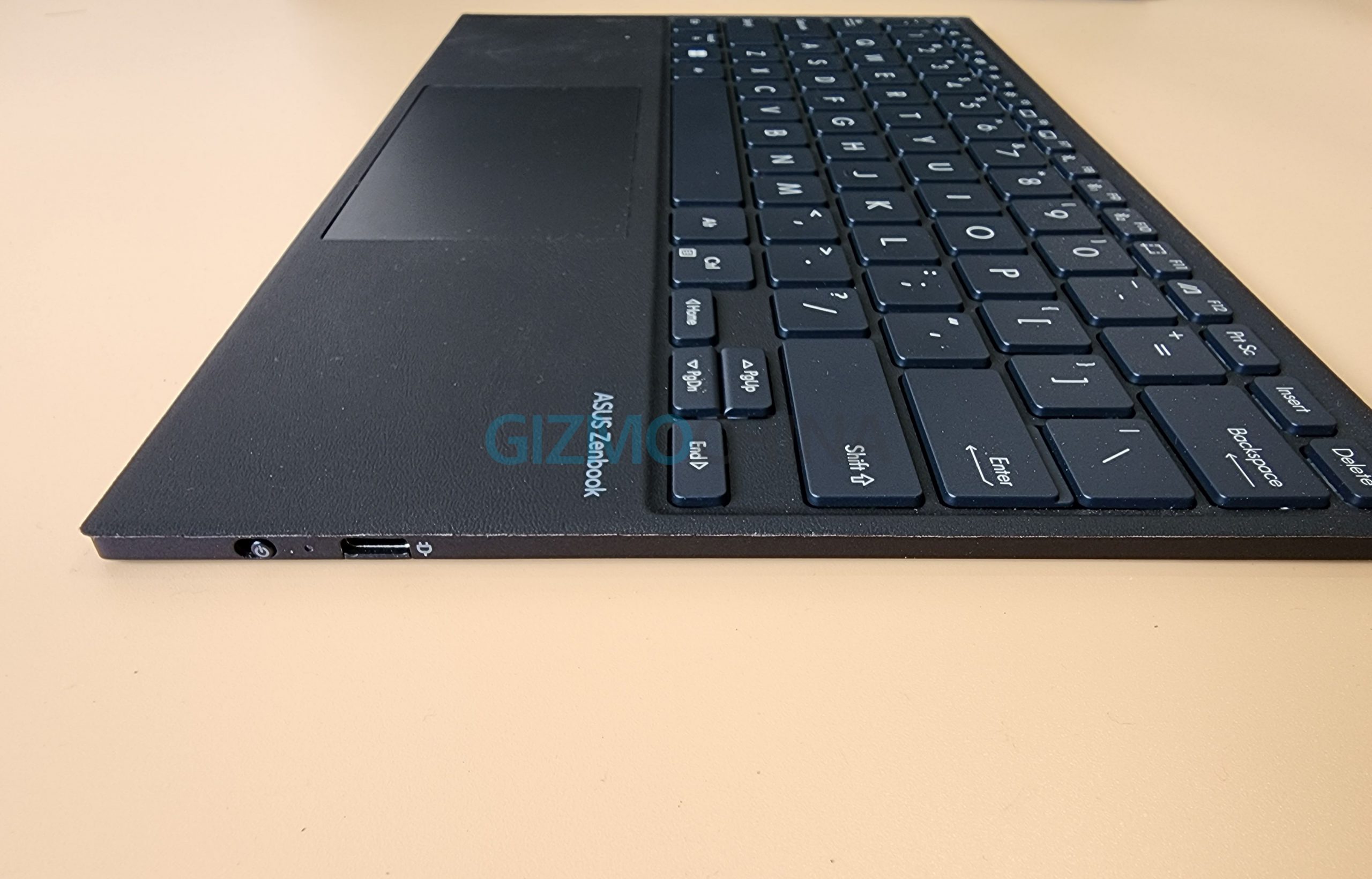
The Bluetooth keyboard is designed to be placed inside the Zenbook 17 Fold OLED. Hence, it has a slim profile of only 5.5mm and weighs 300 grams. This seems to be the reason why it offers 1.4mm key travel and has no backlight. A good thing about the Bluetooth keyboard, which comes with Bluetooth 5.2 connectivity, is that it can be paired with up to two devices. The full-sized keyboard is comfortable to use, and I did not experience any lag while using the keyboard. The Fn key can be used to access additional features like volume increase / decrease, brightness increase / decrease, access webcam, turn on / off touchpad, print screen, and more.
The touchpad comes with a hydrophobic and anti-fingerprint coating. It is clickable and supports gesture control. However, I preferred using the touchscreen to navigate around. When the device is in laptop mode, the webcam half is on top. The Bluetooth keyboard can be magnetically attached only to the other half of the device. It frequently happened that I would forget to turn off the keyboard, and it would just lose its battery juice. While in use, it can last for up to two days. It takes up to four hours to charge the keyboard. It would have been better if the keyboard could be charged while it was attached to the device. By doing so, there would have been no need to separately charge the keyboard.
Performance and Battery Life
| 12th generation Intel Core i7-1250U processor | 1TB M.2 NVMe PCIe 4.0 SSD storage |
| Intel Xe graphics | 75Whr (4-cell Li-Ion), 65W USB-PD charging |
| 16GB of LPDDR5 RAM | Windows 11 Home / Pro |
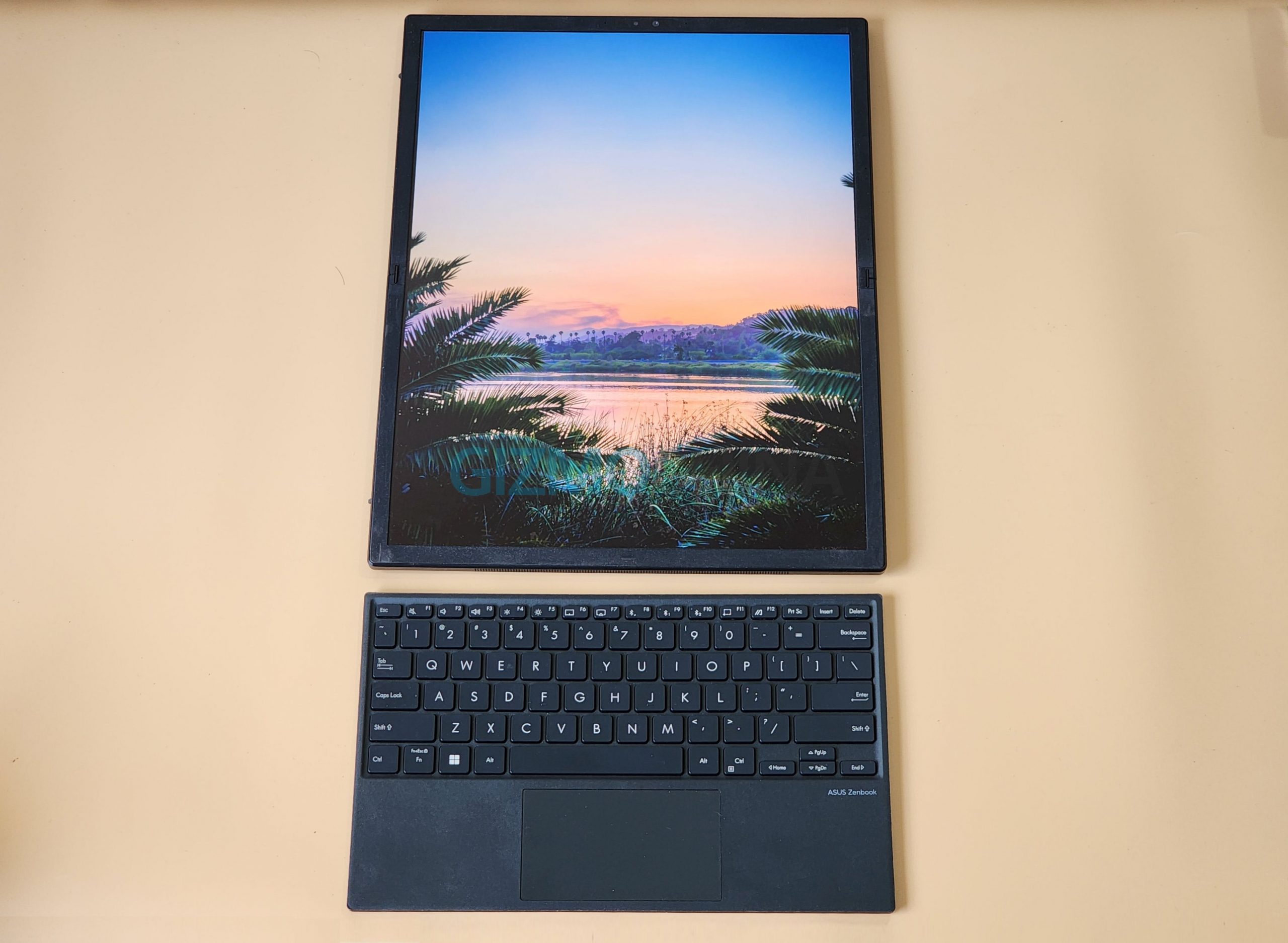
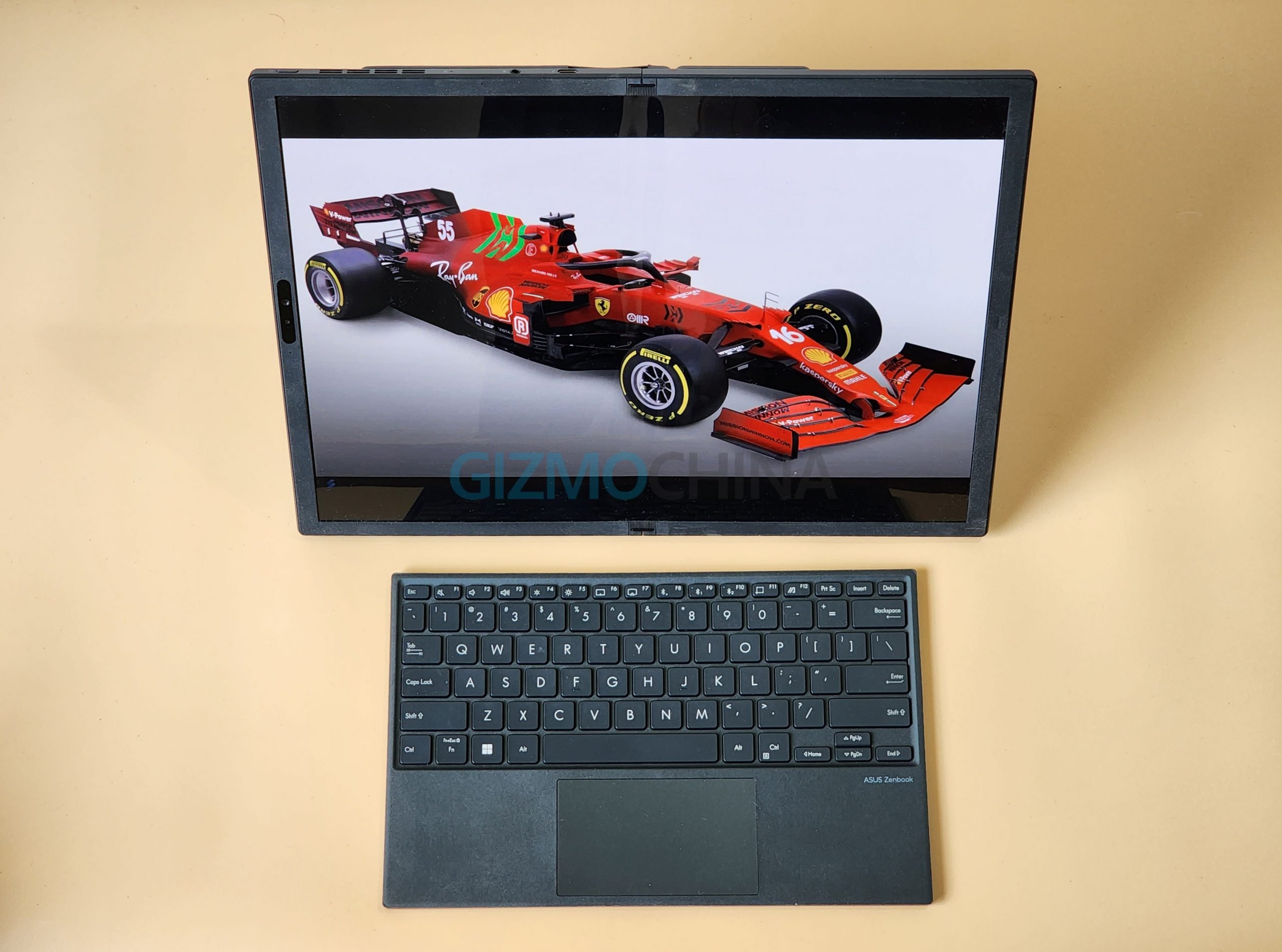
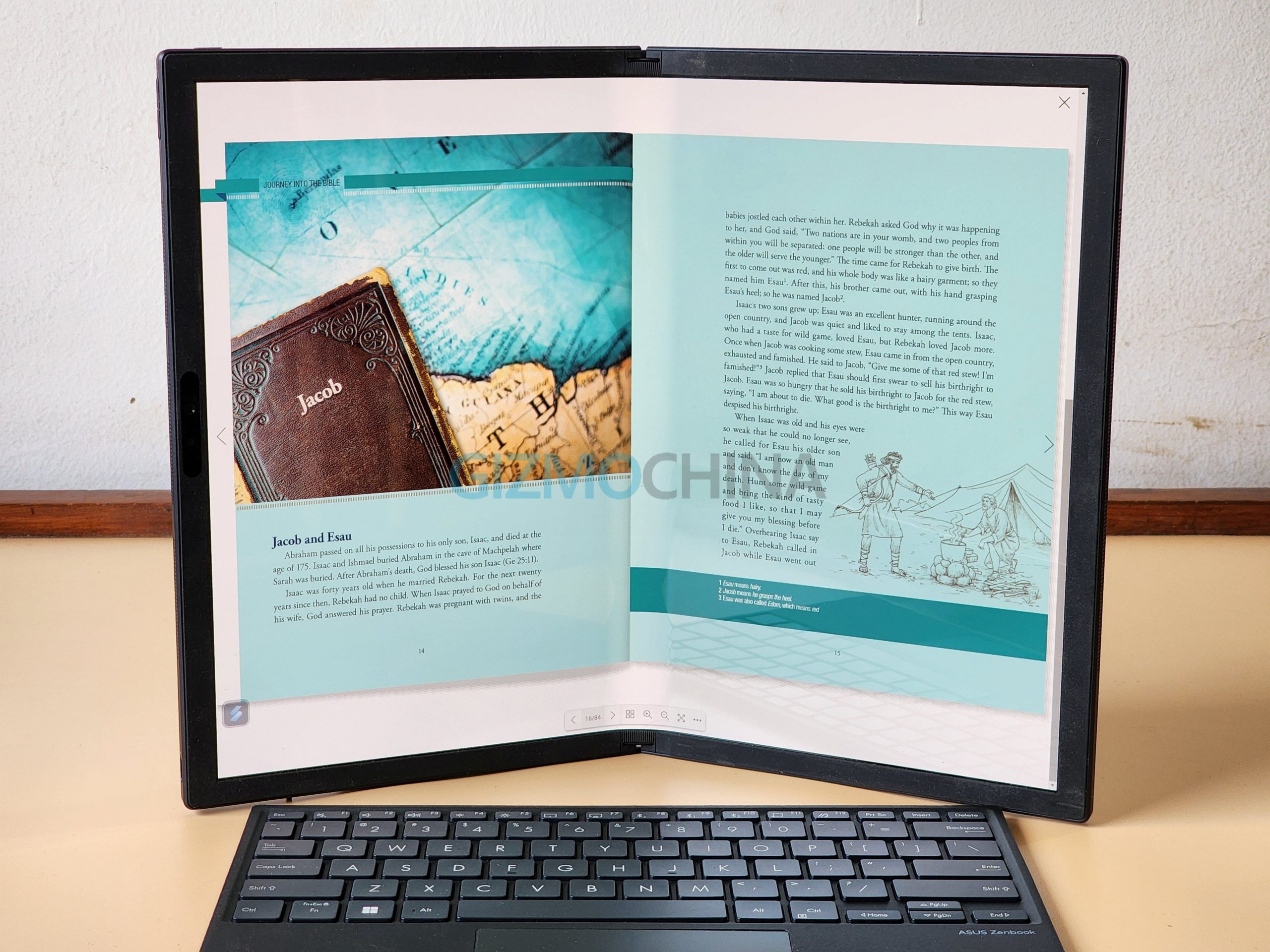
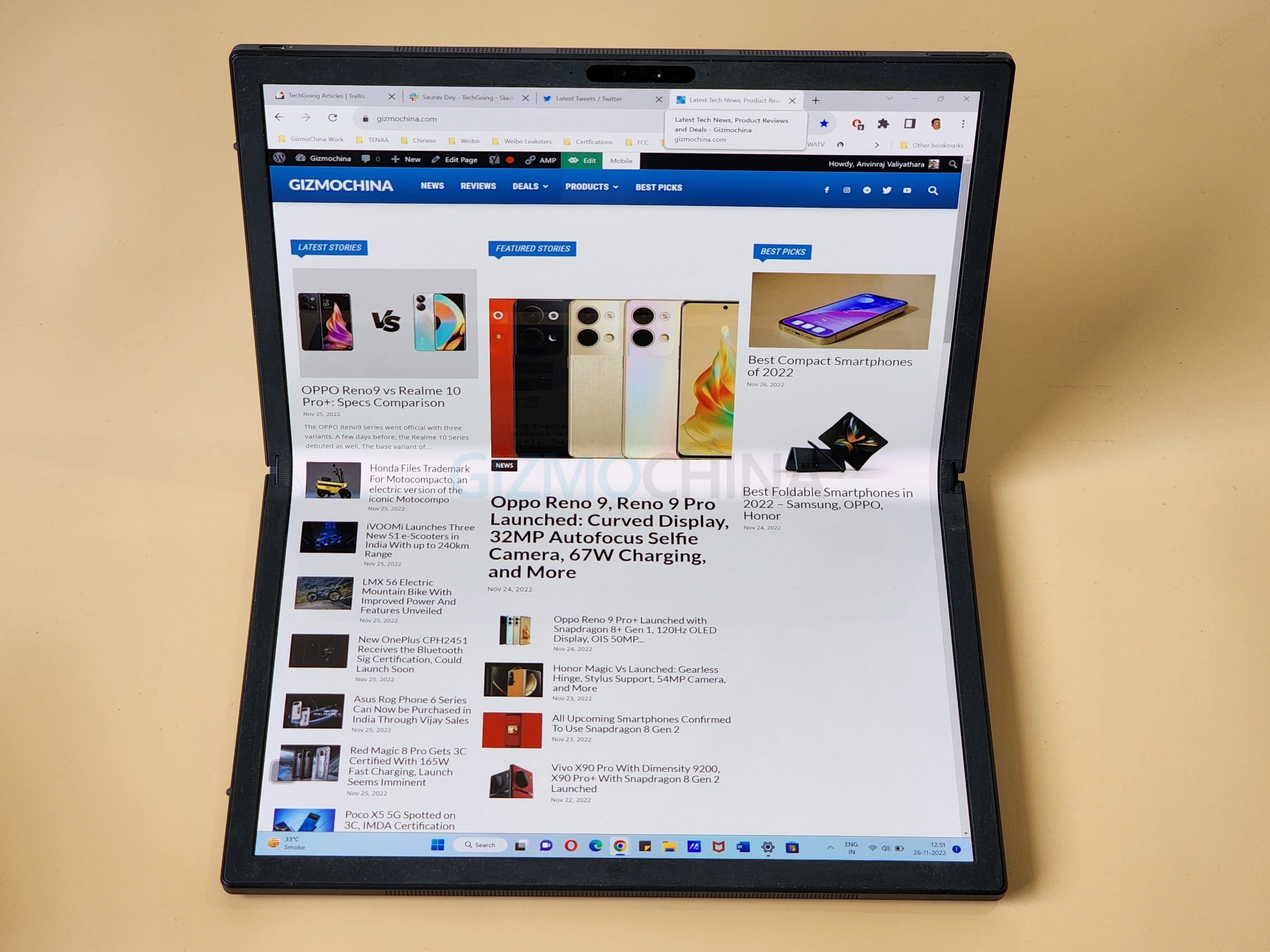
The Zenbook 17 Fold OLED features a 12th-generation Intel Core i7-1250 processor, which has a TDP (Thermal Design Power) of 9W. The processor is paired with 16GB of RAM, which is soldered on the motherboard. There are not many laptops powered by the same processor available on the market. The same processor is used in the HP Envy X360 13 and Dell XPS 9315, both of which cost around Rs 130,000 ($1,570) in India.
The U-series i7 chip is designed for professional use. However, since Asus has used it to power the Zenbook 17 Fold OLED, it appears that it has taken a conservative approach, meaning it is not a very powerful notebook. Nonetheless, I had no problems using three browsers at the same time: Chrome, Edge, and Opera. However, users are going to encounter hiccups in performance if intensive tasks like video editing as it does not feature a discrete GPU.
The ZenFold 17 Fold OLED can be used for light gaming. For heat dissipation, it has a cooling fan and a heatpipe. The 1TB storage space is sufficient for this device. Users can expand the device’s storage, but it is best to do so by contacting Asus technical support.
It runs on Windows 11 Home / Pro and there are some preloaded apps like Disney+, McAfee LiveSafe (trial version), and Microsoft Office Home & Student 2021. Asus’s own apps, such as MyAsus, ScreenXpert 3, and GlideX, also come preinstalled on the device. MyAsus can be used to optimize the performance of the device as well as contact Asus for support. ScreenXpert 3, which stays as a small icon on all screens, provides features like app switching, navigating between opened apps, and a camera / microphone privacy switch. The GlideX app can be used for wired or wireless cross-device screen sharing. These Asus apps are handy, but I seldom use them.
The Zenbook 17 Fold OLED took about 1:30 hours to fully charge. On average, it lasted me around 6 hours in desktop mode. In laptop mode, it offered around 1-2 hours of additional usage time.
Connectivity and Other Features
| 5MP HD webcam | Wi-Fi 6E |
| HD infrared camera | Bluetooth 5 |
| Harman / Kardon quad-speakers | 2 x Thunderbolt 4 ports |
| Dolby Atmos support | 1 x 3.5mm combo audio jack |
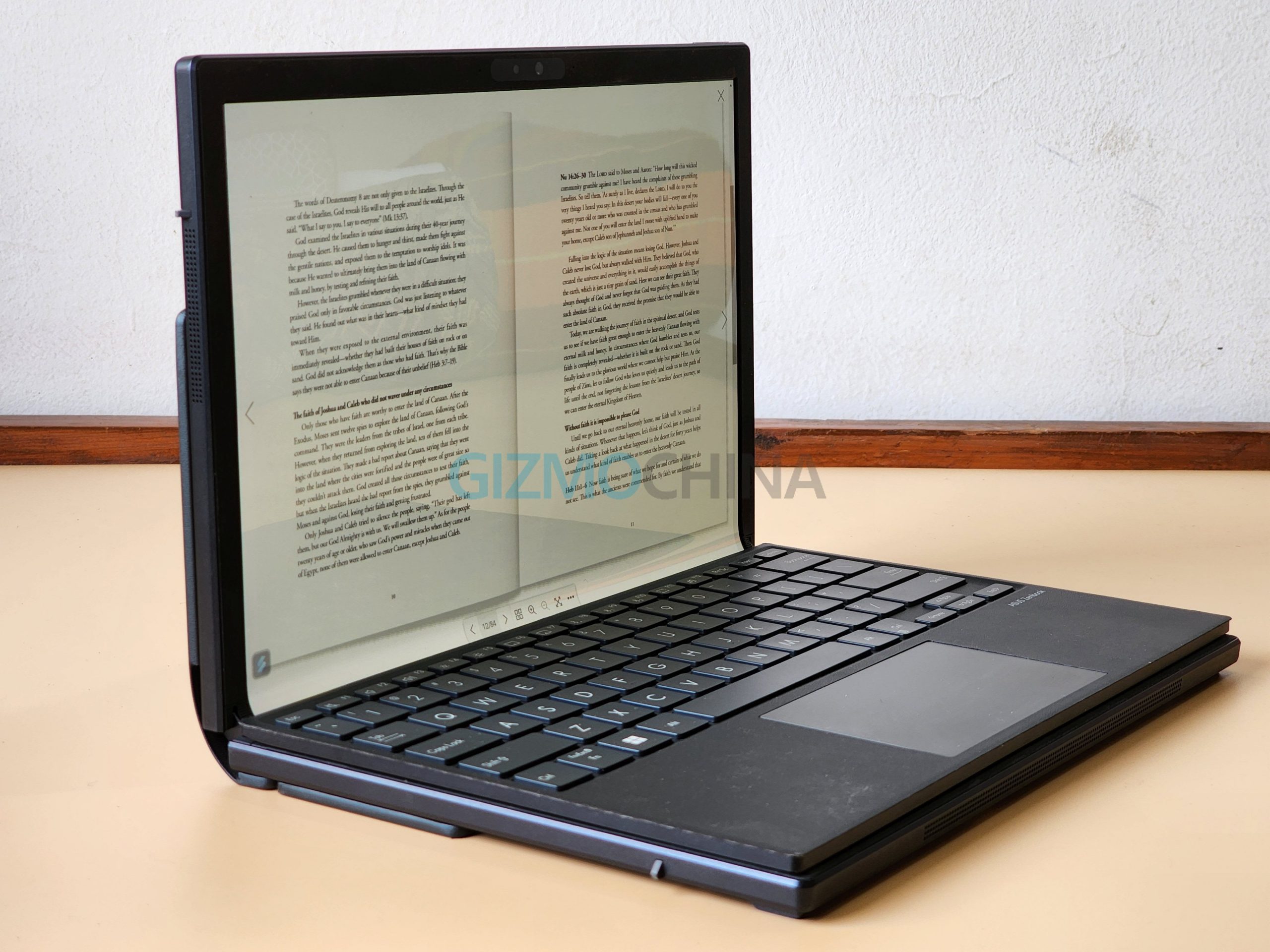
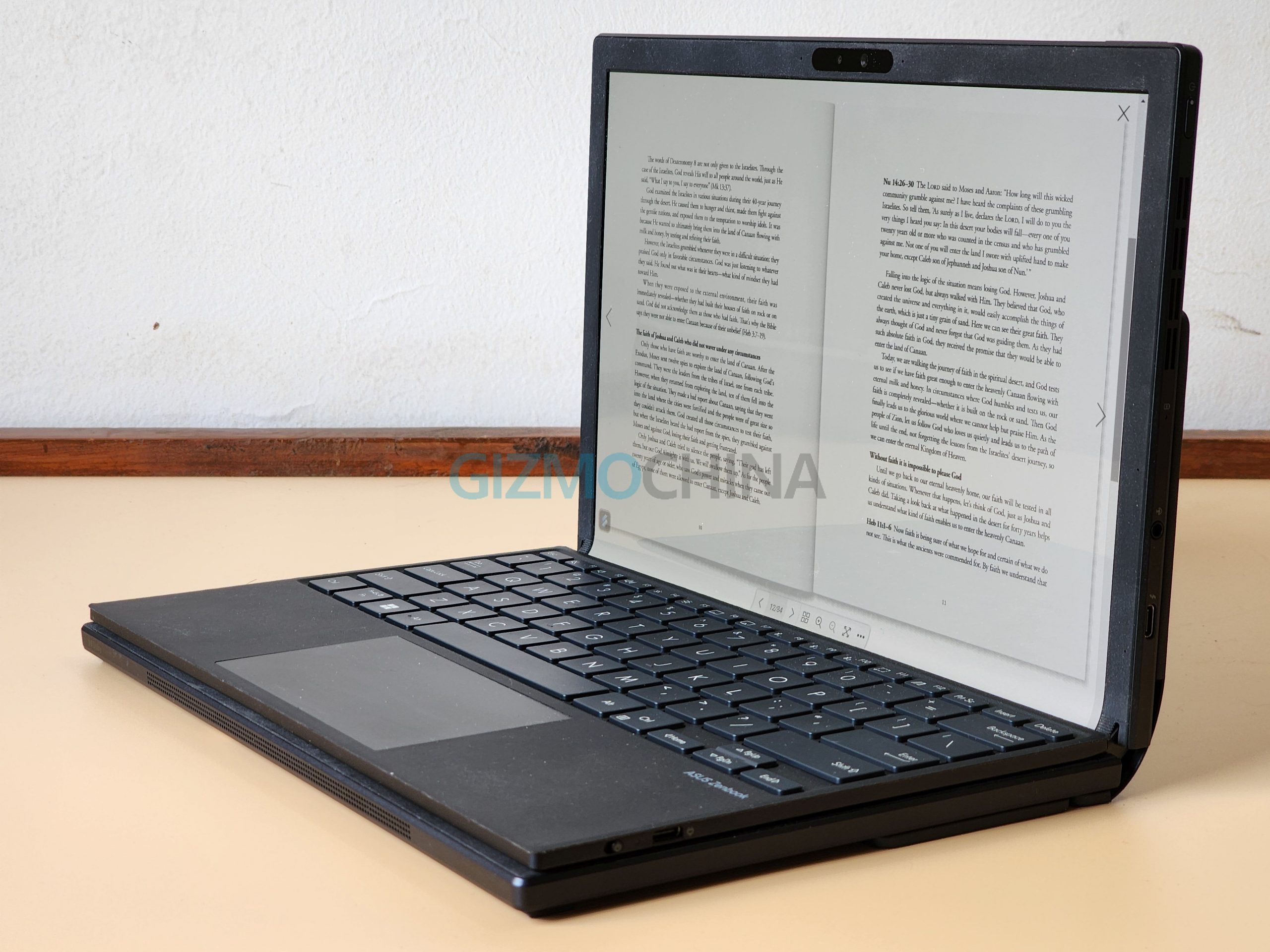
When the Zenbook Fold 17 OLED is used a laptop mode, the 5-megapixel camera is at the top, and the image appears in portrait mode. When it is used in desktop mode, the camera sits on the left side of the screen. The video quality is for video calls. The noise-cancelling array microphones do a pretty good job of making the voice output better.
The HD infrared camera onboard brings support for Windows Hello authentication. It automatically locks the laptop when the user moves away from it. It dims the screen when the user looks away from it. The device lacks a fingerprint scanner. A color sensor is also built into the camera unit. This sensor helps adjust the display’s brightness and color temperature.
The Harman / Kardon quad-speaker system with Dolby Atmos support produces an impressive audio output, that is free of distortion, at the loudest setting. I did not face any issues while connecting to Wi-Fi and Bluetooth on the device.
Verdict
I really loved the experience of using India’s first foldable screen notebook—the Zenbook 17 Fold OLED. The versatile design of the device, which allows it to be used as a compact laptop as well as a desktop PC, is quite impressive.
The two things that I hope Asus improves with the next iteration of the Zenbook 17 Fold OLED, apart from the hefty price, are the keyboard and weight. Because Asus is selling it for Rs 3,29,900 ($3,499 in the US), it is clear that the company is not targeting people looking to buy a device in the mid-range or high-end segment.
The Zenbook 17 Fold OLED can be enticing to people who work in different environments like office, home, travelling, and relaxing. It appears only enthusiasts will be ready to pay such a hefty amount to purchase it. With the company getting almost everything right with its first-generation foldable screen laptop, it is certain that its future foldable screen will certainly offer a better experience. It appears that it will take a couple of years for such a device to become a mass-market product.
Disclaimer: The opinions expressed in this Asus Zenbook 17 Fold OLED review are solely mine based on my experience, and there has been no editorial input from Asus.
RELATED:
- ASUS Gaming Days Sale Till December 23rd Offers Discounts On Gaming Laptops
- Asus unveils PL64 mini PC with Intel Alderlake processors and a tough shell
- ASUS Launches Vivowatch 5 Aero Wristband With Fingertip Pulse Test Support
- Lenovo IdeaPad Gaming 3 16IAH7 Review: Capable Gaming Rig with a Great Display
- Infinix Hot 20 5G Review – Performance, 5G in an Enticing Package
- VIVO X90 Review: The Best Competitor against Xiaomi 13?
- Realme 10 Pro + Review: This screen should be equipped on all phones


